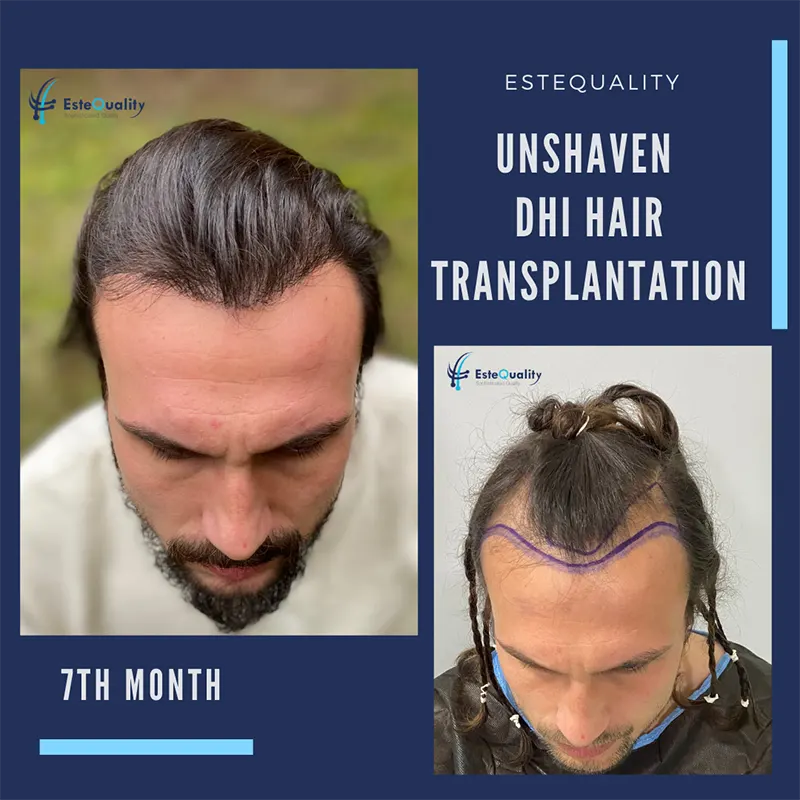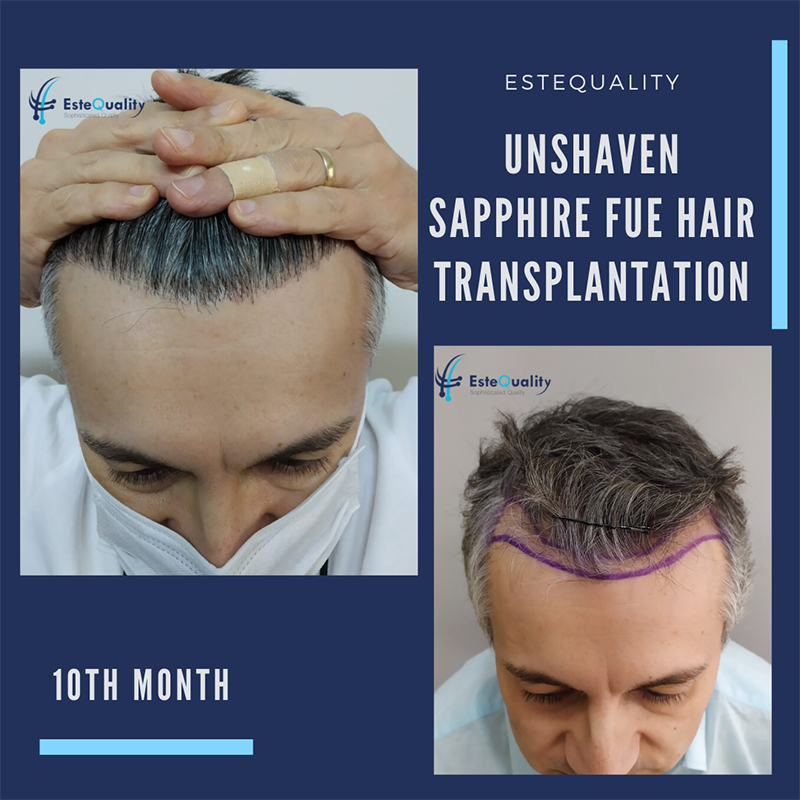What is Unshaven Hair Transplant?
An unshaven hair transplant is a discreet hair restoration technique that allows patients to undergo a transplant procedure without shaving their entire head. Instead of completely removing existing hair, only small donor zones are trimmed where follicular units will be extracted. This makes the surgery virtually undetectable during the healing process and is particularly appealing to professionals and individuals who prefer to keep their appearance unchanged during recovery.
How Does It Work Without Shaving the Head?
In this procedure, the donor area is selectively trimmed in micro-strips or small patches hidden beneath longer surrounding hair. Using a Choi implanter pen (in DHI procedures) or micro punches (in FUE), follicles are harvested and implanted into the recipient area — which can also remain unshaven depending on the case. This method requires more time and surgical precision, but it offers a fully discreet result.
Techniques Used in Unshaven Hair Transplant (DHI, FUE)
Both major techniques used in hair transplantation are compatible with the unshaven approach:
- DHI (Direct Hair Implantation): This technique is ideal for unshaven procedures due to the direct implantation process with the Choi pen. It allows for implanting grafts into existing hair without creating incisions beforehand.
- FUE (Follicular Unit Extraction): This technique uses micro punches to extract hair follicles without a linear scar. With special handling, it can be adapted to unshaven or partially shaved procedures as well.
Benefits of an Unshaven Hair Transplant Procedure
- ✔️ No visible signs of surgery during healing
- ✔️ Natural-looking results without drastic change in appearance
- ✔️ Suitable for professionals or public-facing individuals
- ✔️ Lower psychological stress due to maintained hairstyle
- ✔️ Ideal for small-area corrections or refined hairline work

Who is a Good Candidate for Unshaven Hair Transplant?
The unshaven hair transplant technique is not suitable for everyone — but for the right candidate, it offers a discreet and highly effective solution.
Ideal candidates include:
- Individuals with mild to moderate hair loss
- Patients with strong donor area density
- Men or women who want to avoid shaving for aesthetic or professional reasons
- People seeking small-area restoration (e.g., temples, hairline, crown)
- Patients undergoing revision or touch-up procedures
It is especially popular among women, public figures, and professionals who need to resume work quickly with minimal visual signs of surgery.

Why Choose Turkey for Unshaven Hair Transplant?
Turkey is a world-renowned hub for advanced hair restoration techniques, attracting thousands of international patients annually. The country’s reputation is built on affordability, high-quality medical care, and vast experience in hair transplantation.
Global Reputation and Quality Standards
Top clinics in Turkey—such as EsteQuality—are known for their adherence to international medical standards. Many facilities are ISO-certified, operate in hospital-grade environments, and use FDA-approved tools such as the Choi implanter pen. These high standards offer peace of mind to patients seeking safety and reliability abroad.
Affordable Packages with No Compromise on Quality
Turkey’s pricing structure makes it possible to receive a world-class procedure for a fraction of what it would cost in the UK, EU, or the US. Most clinics offer all-inclusive packages that include:
- Surgeon consultation and personalized treatment planning
- 3–4 nights of hotel accommodation
- Private airport and clinic transfers
- Medical tests, medications, and aftercare kits
- Multilingual support staff
This transparent pricing is particularly attractive for international patients traveling for medical tourism.
Experienced Surgeons in Advanced Techniques
Turkish hair transplant surgeons have conducted thousands of procedures, with many specializing in precision methods like unshaven DHI. Their experience ensures:
- Accurate graft placement
- Higher follicle survival rates
- Aesthetic hairline design
- Lower risk of post-op complications
Esteemed clinics often feature board-certified surgeons, each backed by years of experience in performing hair restoration procedures on a global patient base.

Why EsteQuality Clinic for No-Shave Hair Transplant?
At EsteQuality, we specialize in delivering discreet, high-precision hair transplants that protect both your appearance and your privacy. Our clinic is based in Istanbul, Turkey — a globally trusted destination for cosmetic procedures — and serves patients from across Europe, the Middle East, and North America.
Our Experience with Discreet Procedures
Our medical team has performed hundreds of successful unshaven hair transplants, utilizing the DHI and FUE techniques depending on each patient’s needs. We are particularly experienced in:
- Maintaining existing hairstyles throughout the procedure
- Working around long hair without compromising graft survival
- Performing targeted transplants in the hairline, crown, and temple regions
- Treating female hair loss patients with special attention to density and design
Each case is managed with surgical precision and aesthetic sensitivity.
What Makes Our Approach Different
We take pride in offering a refined, patient-centered experience with:
- ✅ Custom hairline design based on facial proportions and age
- ✅ Use of advanced Choi implanter pens for accurate, no-incision implantation
- ✅ Individual graft control to achieve natural density and direction
- ✅ Pre-op digital scalp analysis and high-resolution imaging
- ✅ Full transparency with before/after photos of real patients
- ✅ Multilingual team offering English, German, Arabic, and French support
At EsteQuality, your comfort, privacy, and satisfaction are not optional — they’re standard.
Unshaven Hair Transplant Cost in Turkey
The cost of an unshaven hair transplant in Turkey typically ranges from €1,800 to €3,500, depending on:
- The number of grafts needed (usually between 1,500–3,500)
- The method used (DHI vs FUE)
- Whether the recipient area also remains unshaven
At EsteQuality, our all-inclusive packages cover:
- Personalized consultation and hair analysis
- Up to 4,000 grafts using DHI or FUE
- Choi implanter pen or micro-punch instruments
- PRP therapy (optional)
- Medications, shampoo, and aftercare kit
Comparing Unshaven Transplant Costs: Turkey vs Europe/US
| Region | Avg. Price (Unshaven DHI) | Inclusions |
| Turkey | €1,800 – €3,500 | Surgery, hotel, transfers, meds |
| UK | €6,000 – €9,000 | Surgery only |
| USA | €8,000 – €12,000 | Surgery only |
Patients save up to 70% by choosing Turkey, without compromising on safety or medical standards.
Recovery and Aftercare in Unshaven Hair Transplants
Healing Timeline and What to Expect
- Day 1–3: Mild redness and sensitivity
- Day 4–7: Scabs form and begin to flake off
- Day 10: Hair can be washed gently with clinic-provided shampoo
- Week 4: Temporary shedding of transplanted hairs (shock loss)
- Month 3–4: Visible new hair growth begins
- Month 8–12: Final results take full shape
Thanks to the no-shave approach, patients often resume work and social activities within just a few days.
Post-Procedure Instructions
- Avoid direct sunlight and physical exercise for 10–14 days
- Use only clinic-approved hair care products for the first month
- Sleep with head slightly elevated to reduce swelling
- Refrain from touching or scratching the recipient area
- Submit follow-up photos for remote evaluation
When Will Results Be Visible?
- Initial shedding: 2–4 weeks post-op
- New growth phase: Begins between 3–4 months
- Noticeable improvement: 6 months
- Full results: Typically visible between 8 and 12 months
At EsteQuality, we monitor your progress through scheduled follow-ups, and our team is available to answer questions at every stage of your recovery.
To find out if you’re a suitable candidate for an unshaven hair transplant, you can call us or send your photos to our medical consultants via WhatsApp. Our consultants will have your photos reviewed by our doctors and will respond shortly, answering all your questions about the procedure.
In addition you can check our packages for more information.
Before and After Unshaven Hair Transplant
Before Unshaven Hair Transplant
Here are the steps you need to take before undergoing an unshaven hair transplant:
- Avoid alcohol and blood thinners: Refrain from consuming alcohol or any blood-thinning substances at least one week prior to the surgery.
- Inform your medical consultant about medications: If you are on any regular medication, it is essential to inform your medical consultant or doctor in advance. Never start or stop any medication without proper guidance.
- Quit smoking and tobacco: You should stop smoking or using tobacco products one week before the procedure.
- Stop physical exercise: Avoid engaging in sports or physical exercise one week before the surgery.
- Consult before cutting your hair: After deciding on the surgery, your suitability for unshaven hair transplant will be determined based on the photos you submit. Do not cut your hair without consulting your doctor or medical consultant.
- Limit caffeine intake: Starting from one day before the surgery, limit tea to a maximum of one cup per day and avoid coffee or green tea completely.
- On the day of surgery: After having breakfast, head to the clinic or hospital. If you will be sedated, avoid eating or drinking anything after midnight the night before. Lunch will be provided during the surgery break.
- Fragrance caution: Since the surgery lasts around seven hours, avoid using strong-scented perfumes.
- Bring appropriate clothing: Make sure to bring zippered or buttoned clothing for post-surgery use. Pull-over clothes can rub against and damage the transplanted areas.
To achieve the best results from your unshaven hair transplant, it is crucial to follow the above guidelines meticulously.
After Unshaven Hair Transplant
Here are the steps to follow after an unshaven hair transplant:
- Medication: Take prescribed medications as directed on the prescription.
- Post-surgery care: On the first day, lie on your back with your head elevated, using the provided neck pillow wrapped in a pad to prevent any fluid or blood from staining your regular pillow (especially if there are any small leaks). If there is significant bleeding, inform your medical consultant immediately.
- Fluid drainage: During the surgery, fluids are injected under the scalp to avoid damaging capillaries. These fluids exit the body through sweat, urine, and small pores on the scalp within four days. Rest as much as possible and keep your head tilted back at a 45-degree angle, avoiding leaning forward. Drink at least three liters of water per day. Failure to follow this may cause fluid to collect near the eyes, leading to swelling. This doesn’t pose a health risk but can be visually bothersome.
- Proper sleeping position: Always sleep on your back, supporting your neck with the neck pillow. Avoid sleeping on your side or stomach. Use the neck pillow as instructed by your medical consultant.
- Avoid contact with the grafted area: For the first 10 days, avoid bumping or rubbing the transplanted area (while getting in and out of cars, changing clothes, sleeping, etc.).
- Itch management: Avoid scratching the scalp with your nails at any time, including areas where grafts weren’t placed. In the first 10 days, if there is an itch, gently pat the area with your fingertips. After 10 days, you can massage the itchy area using circular motions with your palm or fingertips.
- Avoid headwear: Do not wear hats or similar items for the first 10 days.
- Abstain from sexual activity: Refrain from sexual activity for three days after the procedure.
- Avoid alcohol and smoking: Do not consume alcohol or smoke for 10 days post-surgery.
- Avoid swimming and strenuous activity: Stay away from swimming, saunas, steam rooms, tanning beds, and intense exercise for 15 days post-surgery. For heavy sports like boxing or weightlifting, wait at least one month.
- Hair trimming after surgery: The donor area can be trimmed with clippers 30 days post-surgery. However, avoid pressing the clippers too hard against the skin for six months. The transplanted area should only be trimmed with scissors starting three months post-surgery. Avoid razors or blades for at least one year, preferably never using them again.
- Hair coloring: If using herbal dyes, wait four months after surgery. For non-herbal dyes, wait at least six months.
- Numbness and itching: It is normal to experience localized numbness or itching for up to six months after surgery.
- Shedding and regrowth: Around one month post-surgery, some or all of the transplanted hair may shed, and new hair will begin growing around three months later. The full regrowth process takes up to a year, so send monthly photos to your medical consultant for regular follow-ups.
At EsteQuality, we guarantee our hair transplant procedures. If the desired results aren’t achieved due to a medical error, we offer a free revision. This happens in only about 1 in every 1,000 cases.
For additional treatments to strengthen hair growth, improve hair quality, and nourish the scalp, such as vitamins, stem cell therapy, mesotherapy, or PRP, you can contact our medical consultant.
To find out if you’re a suitable candidate for an unshaven hair transplant, you can call us or send your photos to our medical consultants via WhatsApp. Our consultants will have your photos reviewed by our doctors and will respond shortly, answering all your questions about the procedure.
In addition you can check our packages for more information.

Operation Time
5 Hours

Anesthesia
Local Anesthesia
Needle-Free Anesthesia
Sedation

Sensitivity process
3 Days

Return to work
3 Days

Healing process
12 Days

Hospitalization
None
FREQUENTLY ASKED QUESTIONS
Is unshaven hair transplantation can be applied in any technique?
Unshaved hair transplantation can be applied in every technique, such as DHI, FUE, and Sapphire FUE.
Is an unshaven hair transplantation suitable for everyone?
Unshaven hair transplantation is not suitable for everyone. For this operation, you need less than 3000 grafts on average. In addition, you should have long hair.
How many types of anesthesia techniques for unshaven hair transplant are there?
There are 3 types of anesthesia techniques. Local anesthesia, Needle-Free Anesthesia and Sedation.
Local anesthesia is injected with standard needles, and anesthesia is performed on average in five minutes. Afterward, the injected area becomes completely numb. Thus, you will not have pain during and after the operation.
Pain Duration: Average of 5 minutes
Needle-Free Anesthesia is a device that gives anesthesia for the area of the operation by pressure, not by needles. After the site is entirely anesthetized, anesthesia is continued with a needle, and the person does not feel it.
We use this device only in the area where we take the grafts (donor area). Because some bruising occurs after the pressure in the using area, we do not use it in the transplant area.
Needle-free anesthesia is an ideal solution for people with needle phobia.
Pain Duration: Average of 3 minutes
Sedation is when sedative drugs are given before the surgery, and it helps you feel more relaxed during the operation. The anesthesiologist injects the sedative drugs into your vein. You don’t feel pain, but you don’t sleep, either. So you will be able to answer the questions asked. In addition, you will be slumberous during the surgery.
Pain Duration: Painless
To whom is unshaven hair transplantation performed?
Unshaven hair transplantation is performed on men and women with long hair. In people with long hair, it may take several years for the shaved hair to regain its former length. Therefore, thanks to unshaven hair transplantation, they regain their old appearance in a very short time.
What is the difference between unshaven hair transplantation and shaven hair transplantation?
The difference between unshaven hair transplantation and shaven hair transplantation is whether the healing process is noticed by those around you or not. If over 3000 grafts will be transplanted, we strongly recommend shaved hair transplantation.









